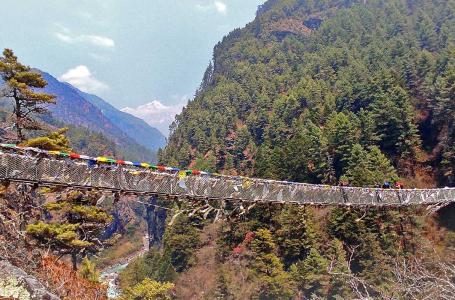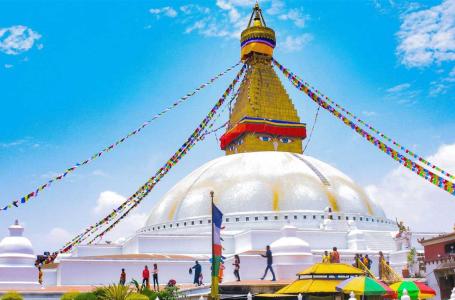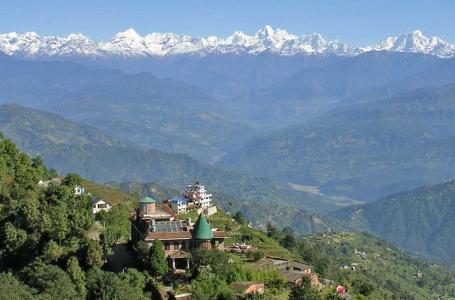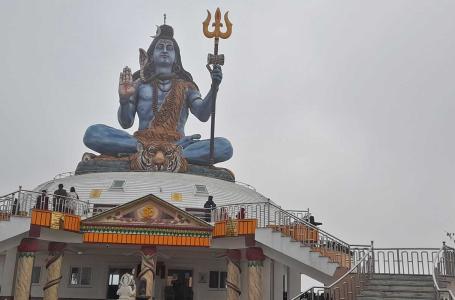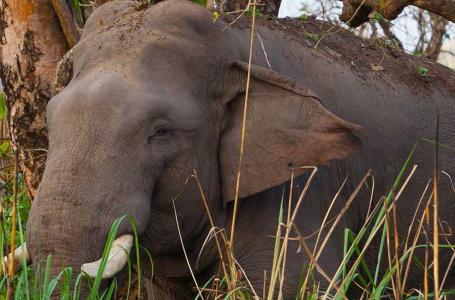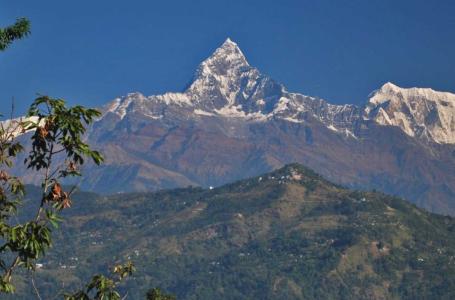Chisapani, Nagarkot, and Dhulikhel Trek take you through some of the exquisite forests, classic villages, rewarding viewpoints, and aesthetic monasteries, existing within the vicinity of Kathmandu. This trek is one of the best ways to come close to nature and feel the natural charisma firsthand. Out of all of them, the views of Everest, Makalu, Cho Oyu, and many other peaks appear magical from the viewpoint of Nagarkot.
Through the wild jungles of Shivapuri National Park, you will arrive at the traditional Sherpa village of Chisapani, overlooking the gorgeous panorama of mountain ranges. Then, you will ascend to the Nagarkot hill station to witness the golden sunrise over the far-reaching Himalayas. Through the off-the-beaten-track to Nala, you will make your way to the Dhulikhel. The next day, after exploring the architecturally and artistically superior Namo Buddha monastery, you will return to Kathmandu.
This short day trek can be done by anybody of any age, but you must be at least fit to walk. Beginners can try this as their first adventure. Within 4 days, you will create some of the best memories of your life.
Don’t worry about the time of the year, because this trek can be done in any season. Make your Chisapani Trek Special with the Trek Mania Nepal.
The Chisapani, Nagarkot, and Dhulikhel trek in Nepal provides an excellent opportunity to see the Kathmandu Valley's natural beauty and cultural legacy. Begin by conducting extensive study, taking insights from guidebooks, internet resources, and travel forums to become acquainted with the path, lodgings, and attractions along the way.
Choose the best season based on the most favorable weather conditions. And get the necessary entrance permits. Pack appropriately for changeable weather and altitudes. If you are going alone, you must hire a local guide because solo travel is prohibited in Nepal. Even if you are traveling in a group, hiring a guide for better cultural understanding and navigation aid is recommended.
Respect local culture and the environment by exploring old temples and villages and engaging with the local people. Carry emergency contacts, including local authorities and embassy information, and be prepared for small injuries or health concerns that may develop throughout the walk for your own protection.
The best times to visit Chisapani, Nagarkot, and Dhulikhel in Nepal are unquestionably spring and fall. Spring (March to May) and fall (September to November) provide the classic hiking experience in this part of the Kathmandu Valley.
The weather in spring is moderate and constant, with warm days and chilly, refreshing evenings. The bright explosion of hues that fills the landscape, with rhododendrons and other wildflowers in full bloom, is what truly distinguishes this season. Clear skies are the usual during this time of year, allowing uninterrupted vistas of the surrounding mountains and adding to the visual magnificence of the walk.
Autumn, on the other hand, provides weather consistency, with moderate daytime temperatures and crisp, energizing nights. The monsoon rains have cleansed the air, revealing unclouded mountain vistas and creating a beautiful environment for trekking in Nepal. The trails are in excellent shape, making the whole trekking experience enjoyable.
On the contrary, due to severe rains and path obstacles, the monsoon season (June to August) should be avoided, as should the winter months (December to February), when freezing temperatures and probable snowfall might disrupt portions of the track.
The accommodations and food choices along the Chisapani, Nagarkot, and Dhulikhel treks combine simplicity and utility to provide hikers with a pleasant and rewarding experience. The walking route emphasizes teahouses and guesthouses as the principal accommodation options, giving adequate shelter without needless frills. Accommodations are generally twin-bedded rooms with simple linen, frequently with communal bathing facilities. Some businesses provide rooms with connected bathrooms for individuals who want a little more solitude, albeit these may be significantly more expensive. The attraction of these hotels rests in their picturesque positions, which allow trekkers to immerse themselves in the region's natural splendor.
Teahouses and guesthouses provide a variety of cuisine tailored to hikers' tastes. This menu features a variety of local and foreign foods. Traditional Nepali food, such as dal bhat, momo, etc, is widely accessible, giving visitors a taste of the country's culinary heritage. International options such as spaghetti, pizza, sandwiches, and fried rice are also available, but at significantly higher rates than local meals. The food at these businesses is typically safe to eat, but for health reasons, it is best to stick to prepared and hot meals and avoid raw vegetables and salads.
The trek commences from Sundarijal, located within a short one-hour drive from Kathmandu. This location functions as the gateway to the trek, and travelers can easily reach Sundarijal by private or local vehicles. Once you reach Sundirijal, the trek will continue on foot which will take you on a scenic route that allows you to immerse themselves in the natural beauty of the trail.
This trek will finally end once you reach Namo Buddha and from there you can take a local bus or private vehicle back to Kathmandu.
Trekking to Chisapani, Nagarkot, and Dhulikhel requires no permits or TIMS, however, there is an entry charge to Shivapuri National Park. Since Sundarijal falls inside Shivapuri National Park, an entry ticket is required.
Cost: Nrs 1000 per person.
A pleasant drive of 13 km will take you to the fabulous Sundarijal, the most popular holiday station for Kathmandu people. At an altitude of 1,350 m, Sundarijal sits as a natural station, far beyond the bustles and noises of the city. The sources of water, greenery, and a peaceful environment are the introductory highlights of the Sundarijal.
The hike to Chisapani starts from here. For the first couple of minutes, you will be walking through the inner trails of the forest. Chirping melody of the birds, the incredible diversity of plants, and the expectations of encountering some wild creatures follow you throughout the journey. Within a while, you will reach the Mul Kharka, a splendid Tamang hamlet. After Mul Kharka, the trail joins the forest again and fluctuates up and down through the serene forest until Chisapani, which is a Sherpa village.
In the evening, enjoy the serene mountain views from the Chisapani. The sunset glimpses from here are just beyond any explanations could justify.
Accommodations
Breakfast: Breakfast at Sundarijal
Lunch: Packed Lunch at Mul Kharka
Dinner: Dinner at Chisapani
A 7-hour trek to Nagarkot is certainly not an easy task. But, the natural jungles of northern Nepal are delusive enough to make you forget all the worries and pains. At times, the path turns steep, but the flat trail compensates for the toil of climbing so high. For lunch, you will stop at the Chauki Bhanjyang. A packed lunch must be carried because there are no hotels or restaurants nearby. Subsequently, after lunch, you will progress towards Nagarkot through the pristine forest of the Shivapuri National Park.
An extensive panorama of mountain ranges greets you to the exotic hill station of Nagarkot. Some of the distinguished peaks are Lhotse (8516 m.), Cho Oyu (8201 m.), Makalu (8463 m.), Manaslu (8163 m.), and Everest (8848 m.). Watch out for the brilliant sunset glimpse from the hilltop of Nagarkot.
Accommodations
Breakfast: Breakfast at Chisapani
Lunch: Packed Lunch at Chauki Bhanjyang
Dinner: lodge at Nagarkot
From Nagarkot, the path to Nala is really exciting as well as fascinating. Out of the two route options, we will choose the most gratifying trail to Nala, where the views of the down valleys and upper peaks are simply unmatched. At times, you will meet the Hindu temples, which are not so aesthetically appealing but spiritually overwhelming. Green trees and unparalleled curiosity of getting surprised are quite normal feelings when you are walking down to the Nala. Once you reach there, take a bus to Dhulikhel and spend the nights there.
Accommodations
Breakfast: Breakfast at Nagarkot
Lunch: Lunch at Nala
Dinner: Dinner at Dhulikhel
To watch the magical mountains, Dhulikhel is one of the closest destinations to Kathmandu. The sunrise glimpse over the top of the snowy spires appears spectacular. After having breakfast, catch a short day hike to Namobuddha, an artistically embellished Buddhist monastery.
The paintings of Buddha and his disciples adorn the inner walls of the monastery. Statues and carvings depict the ideologies of Buddha. Namo Buddha is indeed one of the must-visit sites near Kathmandu. Plus, the views of the mountains are more clear and wonderful from this monastery. After spending quality time there, drive back to Kathmandu for the night stay.
Accommodations
Breakfast: Breakfast at Dhulikhel
Lunch: Packed Lunch at Namo Buddha
Dinner: Dinner at Kathmandu
Trip Start and End Point
Kathmandu / Kathmandu
| DATES | STATUS | PRICE | SPACE LEFT | ||||
|---|---|---|---|---|---|---|---|
|
Start date: 27-Apr, 2025
End date: 30-Apr, 2025 |
Guaranteed | USD 450 |
2
|
Book Now | |||
|
Start date: 04-May, 2025
End date: 07-May, 2025 |
Guaranteed | USD 450 |
1
|
Book Now | |||
|
Start date: 11-May, 2025
End date: 14-May, 2025 |
Guaranteed | USD 450 |
2
|
Book Now | |||
|
Start date: 25-May, 2025
End date: 28-May, 2025 |
Guaranteed | USD 450 |
2
|
Book Now | |||
|
Start date: 03-Aug, 2025
End date: 06-Aug, 2025 |
Guaranteed | USD 450 |
2
|
Book Now | |||
|
Start date: 10-Aug, 2025
End date: 13-Aug, 2025 |
Guaranteed | USD 450 |
1
|
Book Now | |||
|
Start date: 17-Aug, 2025
End date: 20-Aug, 2025 |
Guaranteed | USD 450 |
2
|
Book Now | |||
|
Start date: 24-Aug, 2025
End date: 27-Aug, 2025 |
Guaranteed | USD 450 |
3
|
Book Now | |||
|
Start date: 31-Aug, 2025
End date: 03-Sep, 2025 |
Guaranteed | USD 450 |
2
|
Book Now | |||
|
Start date: 07-Sep, 2025
End date: 10-Sep, 2025 |
Guaranteed | USD 450 |
1
|
Book Now | |||
|
Start date: 14-Sep, 2025
End date: 17-Sep, 2025 |
Guaranteed | USD 450 |
2
|
Book Now | |||
|
Start date: 28-Sep, 2025
End date: 01-Oct, 2025 |
Guaranteed | USD 450 |
3
|
Book Now | |||
|
Start date: 05-Oct, 2025
End date: 08-Oct, 2025 |
Guaranteed | USD 450 |
2
|
Book Now | |||
This trek offers a perfect blend of Himalayan views, peaceful nature trails, and cultural experiences, with breathtaking sunrises over the Langtang, Ganesh Himal, and Everest ranges from Nagarkot and Dhulikhel.
The trek passes through Shivapuri National Park, dense forests, terraced fields, and charming hilltop villages, providing a mix of nature, wildlife, and rural Nepalese culture.
Yes, the trail is well-marked and suitable for solo trekkers. However, hiring a guide enhances the experience, providing insights into the local culture, history, and landscapes.
Yes, Dhulikhel and Nagarkot have ancient temples, monasteries, and traditional Newari architecture, offering a glimpse into Nepal’s rich cultural heritage.
Yes, the gradual altitude gain and moderate trails make it an excellent preparation trek before attempting higher-altitude treks like Everest Base Camp or the Annapurna Circuit.

